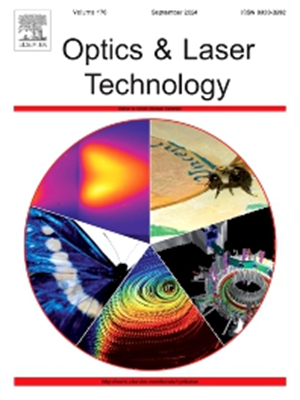飞秒激光诱导了梯度阻抗匹配结构,实现了多光谱电磁波吸收性能
IF 5
2区 物理与天体物理
Q1 OPTICS
引用次数: 0
摘要
优化阻抗匹配是提高电磁吸波材料性能的关键。本研究利用不同相邻光斑距离的飞秒激光(fs)在SiCf/SiCN复合材料上制备了具有组分梯度和结构梯度的梯度阻抗匹配层。结果表明,当光斑距离为30 μm时,该材料的电磁波吸收效果最佳,反射系数最小(rmin)为- 15 dB,厚度为2.05 mm,在9.9 GHz频率处的吸收性能达到96.8%,在uv - nir波段的吸收性能达到82%。这是由于适当的相邻光斑距离使得激光照射的SiCf/SiCN复合材料表面可以从结构和成分上形成纳米颗粒附着的沙丘状周期性结构,从而调节阻抗匹配。此外,激光诱导的缺陷和纳米非均质界面增加了极化损耗。本研究为研究SiCf/SiCN复合材料的多谱电磁波吸收特性提供了一种新的技术途径。本文章由计算机程序翻译,如有差异,请以英文原文为准。
Femtosecond laser induced the graded impedance matching structure to achieve multi-spectrum EM wave absorption performance
Optimal impedance matching is crucial for enhancing the performance of electromagnetic (EM) absorbing materials. In this study, a gradient impedance matching layer with component gradient and structural gradient was prepared on SiCf/SiCN composites by femtosecond laser (fs laser) with different adjacent spot distance. The results show that the EM wave absorption is optimal when the spot distance is 30 μm, possessing the minimum reflection coefficient (RCmin)of −15 dB with a thickness of 2.05 mm, and the absorption performance at the frequency of 9.9 GHz reaches 96.8 %, while the absorption in the UV-to-NIR ranges reaches 82 %. This is attributed to the appropriate adjacent spot distance which allows the fs laser irradiated SiCf/SiCN composites surface to build nanoparticle-attached dune-like periodic structures from the structure and composition together regulating the impedance matching. In addition, fs laser induced defects and nano-heterogeneous interfaces enhance the polarization loss. This study provides a new technological approach to the multi-spectrum EM wave absorption properties of SiCf/SiCN composites.
求助全文
通过发布文献求助,成功后即可免费获取论文全文。
去求助
来源期刊
CiteScore
8.50
自引率
10.00%
发文量
1060
审稿时长
3.4 months
期刊介绍:
Optics & Laser Technology aims to provide a vehicle for the publication of a broad range of high quality research and review papers in those fields of scientific and engineering research appertaining to the development and application of the technology of optics and lasers. Papers describing original work in these areas are submitted to rigorous refereeing prior to acceptance for publication.
The scope of Optics & Laser Technology encompasses, but is not restricted to, the following areas:
•development in all types of lasers
•developments in optoelectronic devices and photonics
•developments in new photonics and optical concepts
•developments in conventional optics, optical instruments and components
•techniques of optical metrology, including interferometry and optical fibre sensors
•LIDAR and other non-contact optical measurement techniques, including optical methods in heat and fluid flow
•applications of lasers to materials processing, optical NDT display (including holography) and optical communication
•research and development in the field of laser safety including studies of hazards resulting from the applications of lasers (laser safety, hazards of laser fume)
•developments in optical computing and optical information processing
•developments in new optical materials
•developments in new optical characterization methods and techniques
•developments in quantum optics
•developments in light assisted micro and nanofabrication methods and techniques
•developments in nanophotonics and biophotonics
•developments in imaging processing and systems

 求助内容:
求助内容: 应助结果提醒方式:
应助结果提醒方式:


